Rice Bran Biorefinery: A Zero-Waste Approach to Bioactive Oil and Biopolymer Production
Abstract
1. Introduction
2. Materials and Methods
2.1. Rice Bran Material and Oil Extraction
2.2. Properties of the Rice Bran Oil
2.3. In Vitro Evaluation of the Rice Bran Oil
2.4. Assessment of Rice Bran Oil for Effective Post-Harvest Disease Control in Grapes and Lemons
2.5. Microbial Production of PHBV by Haloferax mediterranei
2.6. PHBV Extraction and Purification
2.7. Lignin, Hemicellulose, and Cellulose from Fermented Rice Bran
2.8. Statistical Analysis
3. Results
3.1. Properties of Bran Oil
3.2. In Vitro Evaluation of the Antifungal Activity of Bran Oil
3.3. In Vivo Evaluation of the Antifungal Activity of Bran Oil
3.4. PHB Production with Haloferax mediterranei
3.5. PHB Extraction and Purification
3.6. Lignin, Hemicellulose and Cellulose Extraction Yield from Digested Rice Bran
4. Discussion
4.1. Extraction, In Vitro Validation, and Application of the Crude Rice Bran Extract in Edible Coatings
4.2. Biological Production of PHB(V) from Defatted Rice Bran
4.3. Lignin, Cellulose, and Hemicellulose from Defatted and Fermented Rice Bran
4.4. Biorefineries
5. Conclusions
Supplementary Materials
Author Contributions
Funding
Institutional Review Board Statement
Informed Consent Statement
Data Availability Statement
Conflicts of Interest
References
- Qiao, H.; Zheng, F.; Jiang, H.; Dong, K. The Greenhouse Effect of the Agriculture-Economic Growth-Renewable Energy Nexus: Evidence from G20 Countries. Sci. Total Environ. 2019, 671, 722–731. [Google Scholar] [CrossRef]
- G20 Osaka Leaders’ Declaration. Available online: https://www.mofa.go.jp/policy/economy/g20_summit/osaka19/en/documents/final_g20_osaka_leaders_declaration.html (accessed on 3 June 2025).
- Makepa, D.C.; Chihobo, C.H. Barriers to Commercial Deployment of Biorefineries: A Multi-Faceted Review of Obstacles across the Innovation Chain. Heliyon 2024, 10, e32649. [Google Scholar] [CrossRef]
- Pérez-Almada, D.; Galán-Martín, Á.; Contreras, M.d.M.; Castro, E. Integrated Techno-Economic and Environmental Assessment of Biorefineries: Review and Future Research Directions. Sustain. Energy Fuels 2023, 7, 4031–4050. [Google Scholar] [CrossRef]
- Juliano, B.O.; Tuaño, A.P.P. Gross Structure and Composition of the Rice Grain. In Rice: Chemistry and Technology; Elsevier: Amsterdam, The Netherlands, 2018; pp. 31–53. ISBN 9780128115084. [Google Scholar]
- Goswami, S.B.; Mondal, R.; Mandi, S.K. Crop Residue Management Options in Rice–Rice System: A Review. Arch. Agron. Soil Sci. 2020, 66, 1218–1234. [Google Scholar] [CrossRef]
- Garba, U.; Thongsook, T. Extraction and Utilization of Rice Bran Oil: A Review. In Proceedings of the 4th International Conference on Rice Bran Oil 2017 (ICRBO 2017), Bangkok, Thailand, 24–25 August 2017. [Google Scholar]
- Kumar, P.; Yadav, D.; Kumar, P.; Panesar, P.S.; Bunkar, D.S.; Mishra, D.; Chopra, H.K. Comparative Study on Conventional, Ultrasonication and Microwave Assisted Extraction of γ-Oryzanol from Rice Bran. J. Food Sci. Technol. 2016, 53, 2047–2053. [Google Scholar] [CrossRef] [PubMed]
- Martillanes, S.; Ayuso-Yuste, M.C.; Gil, M.V.; Manzano-Durán, R.; Delgado-Adámez, J. Bioavailability, Composition and Functional Characterization of Extracts from Oryza sativa L. Bran. Food Res. Int. 2018, 111, 299–305. [Google Scholar] [CrossRef]
- Kim, H.W.; Kim, J.B.; Cho, S.-M.; Cho, I.K.; Li, Q.X.; Jang, H.-H.; Lee, S.-H.; Lee, Y.-M.; Hwang, K.-A. Characterization and Quantification of γ-Oryzanol in Grains of 16 Korean Rice Varieties. Int. J. Food Sci. Nutr. 2015, 66, 166–174. [Google Scholar] [CrossRef]
- Martillanes, S.; Rocha-Pimienta, J.; Gil, M.V.; Ayuso-Yuste, M.C.; Delgado-Adámez, J. Antioxidant and Antimicrobial Evaluation of Rice Bran (Oryza sativa L.) Extracts in a Mayonnaise-Type Emulsion. Food Chem. 2020, 308, 125633. [Google Scholar] [CrossRef]
- Park, H.-Y.; Lee, K.-W.; Choi, H.-D. Rice Bran Constituents: Immunomodulatory and Therapeutic Activities. Food Funct. 2017, 8, 935–943. [Google Scholar] [CrossRef]
- Wang, D.; Wang, G.; Wang, J.; Zhai, H.; Xue, X. Inhibitory Effect and Underlying Mechanism of Cinnamon and Clove Essential Oils on Botryosphaeria dothidea and Colletotrichum gloeosporioides Causing Rots in Postharvest Bagging-Free Apple Fruits. Front. Microbiol. 2023, 14, 1109028. [Google Scholar] [CrossRef]
- Maurya, A.; Prasad, J.; Das, S.; Dwivedy, A.K. Essential Oils and Their Application in Food Safety. Front. Sustain. Food Syst. 2021, 5, 653420. [Google Scholar] [CrossRef]
- Oliveira, J.; Parisi, M.C.M.; Baggio, J.S.; Silva, P.P.M.; Paviani, B.; Spoto, M.H.F.; Gloria, E.M. Control of Rhizopus stolonifer in Strawberries by the Combination of Essential Oil with Carboxymethylcellulose. Int. J. Food Microbiol. 2019, 292, 150–158. [Google Scholar] [CrossRef]
- Ghatge, S.; Yang, Y.; Ahn, J.H.; Hur, H.G. Biodegradation of Polyethylene: A Brief Review. Appl. Biol. Chem. 2020, 63, 27. [Google Scholar] [CrossRef]
- Danso, D.; Chow, J.; Streita, W.R. Plastics: Environmental and Biotechnological Perspectives on Microbial Degradation. Appl. Environ. Microbiol. 2019, 85, e01095-19. [Google Scholar] [CrossRef] [PubMed]
- Kawecki, D.; Nowack, B. Polymer-Specific Modeling of the Environmental Emissions of Seven Commodity Plastics as Macro- and Microplastics. Environ. Sci. Technol. 2019, 53, 9664–9676. [Google Scholar] [CrossRef] [PubMed]
- Blanc, S.; Massaglia, S.; Brun, F.; Peano, C.; Mosso, A.; Giuggioli, N.R. Use of Bio-Based Plastics in the Fruit Supply Chain: An Integrated Approach to Assess Environmental, Economic, and Social Sustainability. Sustainability 2019, 11, 2475. [Google Scholar] [CrossRef]
- Maraveas, C. Production of Sustainable and Biodegradable Polymers from Agricultural Waste. Polymers 2020, 12, 1127. [Google Scholar] [CrossRef]
- Tsang, Y.F.; Kumar, V.; Samadar, P.; Yang, Y.; Lee, J.; Ok, Y.S.; Song, H.; Kim, K.H.; Kwon, E.E.; Jeon, Y.J. Production of Bioplastic through Food Waste Valorization. Environ. Int. 2019, 127, 625–644. [Google Scholar] [CrossRef]
- Santin, A.; Spatola Rossi, T.; Morlino, M.S.; Gupte, A.P.; Favaro, L.; Morosinotto, T.; Treu, L.; Campanaro, S. Autotrophic Poly-3-Hydroxybutyrate Accumulation in Cupriavidus necator for Sustainable Bioplastic Production Triggered by Nutrient Starvation. Bioresour. Technol. 2024, 406, 131068. [Google Scholar] [CrossRef]
- Sen, K.Y.; Hussin, M.H.; Baidurah, S. Biosynthesis of Poly(3-Hydroxybutyrate) (PHB) by Cupriavidus necator from Various Pretreated Molasses as Carbon Source. Biocatal. Agric. Biotechnol. 2019, 17, 51–59. [Google Scholar] [CrossRef]
- Huang, T.Y.; Duan, K.J.; Huang, S.Y.; Chen, C.W. Production of Polyhydroxyalkanoates from Inexpensive Extruded Rice Bran and Starch by Haloferax mediterranei. J. Ind. Microbiol. Biotechnol. 2006, 33, 701–706. [Google Scholar] [CrossRef] [PubMed]
- Torben, S.; Jørgen, H.; Louise Krogh, J. Straw to Energy, 2nd ed.; Food & Bio Cluster Denmark: Aarhus, Denmark, 2021. [Google Scholar]
- Almeida, P.V.; Gando-Ferreira, L.M.; Quina, M.J. Tomato Residue Management from a Biorefinery Perspective and towards a Circular Economy. Foods 2024, 13, 1873. [Google Scholar] [CrossRef] [PubMed]
- Casa, M.; Miccio, M.; de Feo, G.; Paulillo, A.; Chirone, R.; Paulillo, D.; Lettieri, P.; Chirone, R. A Brief Overview on Valorization of Industrial Tomato By-Products Using the Biorefinery Cascade Approach. Detritus 2021, 15, 31–39. [Google Scholar] [CrossRef]
- Turoli, D.; Testolin, G.; Zanini, R.; Bellù, R. Determination of Oxidative Status in Breast and Formula Milk. Acta Paediatr. Int. J. Paediatr. 2004, 93, 1569–1574. [Google Scholar] [CrossRef]
- Rawte, T.; Mav, S. A Rapid Hypochlorite Method for Extraction of Polyhydroxy Alkanoates from Bacterial Cells. Indian J. Exp. Biol. 2002, 40, 924–929. [Google Scholar]
- Xu, F.; Sun, J.X.; Sun, R.; Fowler, P.; Baird, M.S. Comparative Study of Organosolv Lignins from Wheat Straw. Ind. Crops. Prod. 2006, 23, 180–193. [Google Scholar] [CrossRef]
- Hernández-Coronado, M.J.; Hernández, M.; Centenera, F.; Pérez-Leblic, M.I.; Ball, A.S.; Arias, M.E. Chemical Characterization and Spectroscopic Analysis of the Solubilization Products from Wheat Straw Produced by Streptomyces Strains Grown in Solid-State Fermentation. Microbiology 1997, 143, 1359–1367. [Google Scholar] [CrossRef]
- Ruen-ngam, D.; Thawai, C.; Sukonthamut, S.; Nokkoul, R.; Tadtong, S. Evaluation of Nutrient Content and Antioxidant, Neuritogenic, and Neuroprotective Activities of Upland Rice Bran Oil. ScienceAsia 2018, 44, 257–267. [Google Scholar] [CrossRef]
- Zhang, D.; Duan, X.; Wang, Y.; Shang, B.; Liu, H.; Sun, H.; Wang, Y. A Comparative Investigation on Physicochemical Properties, Chemical Composition, and in Vitro Antioxidant Activities of Rice Bran Oils from Different Japonica Rice (Oryza sativa L.) Varieties. J. Food Meas. Charact. 2021, 15, 2064–2077. [Google Scholar] [CrossRef]
- Ramezanzadeh, F.M.; Rao, R.M.; Windhauser, M.; Prinyawiwatkul, W.; Marshall, W.E. Prevention of Oxidative Rancidity in Rice Bran during Storage. J. Agric. Food Chem. 1999, 47, 2997–3000. [Google Scholar] [CrossRef]
- He, R.; Wang, Y.; Zou, Y.; Wang, Z.; Ding, C.; Wu, Y.; Ju, X. Storage Characteristics of Infrared Radiation Stabilized Rice Bran and Its Shelf-life Evaluation by Prediction Modeling. J. Sci. Food Agric. 2020, 100, 2638–2647. [Google Scholar] [CrossRef]
- Rashid, M.T.; Liu, K.; Han, S.; Jatoi, M.A. The Effects of Thermal Treatment on Lipid Oxidation, Protein Changes, and Storage Stabilization of Rice Bran. Foods 2022, 11, 4001. [Google Scholar] [CrossRef] [PubMed]
- Liu, Y.; Zhang, H.; Yi, C.; Quan, K.; Lin, B. Chemical Composition, Structure, Physicochemical and Functional Properties of Rice Bran Dietary Fiber Modified by Cellulase Treatment. Food Chem. 2021, 342, 128352. [Google Scholar] [CrossRef]
- Noshirvani, N. Essential Oils as Natural Food Preservatives: Special Emphasis on Antimicrobial and Antioxidant Activities. J. Food Qual. 2024, 2024, 5807281. [Google Scholar] [CrossRef]
- Basak, S.; Guha, P. A Review on Antifungal Activity and Mode of Action of Essential Oils and Their Delivery as Nano-Sized Oil Droplets in Food System. J. Food Sci. Technol. 2018, 55, 4701–4710. [Google Scholar] [CrossRef] [PubMed]
- Liu, Q.; Chen, Q.; Liu, H.; Du, Y.; Jiao, W.; Sun, F.; Fu, M. Rhizopus stolonifer and Related Control Strategies in Postharvest Fruit: A Review. Heliyon 2024, 10, e29522. [Google Scholar] [CrossRef]
- Xu, X.; Chen, Y.; Li, B.; Zhang, Z.; Qin, G.; Chen, T.; Tian, S. Molecular Mechanisms Underlying Multi-Level Defense Responses of Horticultural Crops to Fungal Pathogens. Hortic. Res. 2022, 9, uhac066. [Google Scholar] [CrossRef]
- Liu, C.; Xi, X.; Liu, Y.; Lu, Y.; Che, F.; Gu, Y.; Yu, Y.; Li, H.; Liu, J.; Wei, Y. Isolation of Four Major Compounds of γ-Oryzanol from Rice Bran Oil by Ionic Liquids Modified High-Speed Countercurrent Chromatography and Antimicrobial Activity and Neuroprotective Effect of Cycloartenyl Ferulate In Vitro. Chromatographia 2021, 84, 635–644. [Google Scholar] [CrossRef]
- Mitchell, P. Coupling of Phosphorylation to Electron and Hydrogen Transfer by a Chemi-Osmotic Type of Mechanism. Nature 1961, 191, 144–148. [Google Scholar] [CrossRef]
- Stock, D.; Gibbons, C.; Arechaga, I.; Leslie, A.G.W.; Walker, J.E. The Rotary Mechanism of ATP Synthase. Curr. Opin. Struct. Biol. 2000, 10, 672–679. [Google Scholar] [CrossRef]
- Ju, J.; Xie, Y.; Guo, Y.; Cheng, Y.; Qian, H.; Yao, W. Application of Edible Coating with Essential Oil in Food Preservation. Crit. Rev. Food Sci. Nutr. 2019, 59, 2467–2480. [Google Scholar] [CrossRef]
- Long, N.; Li, F. Antifungal Mechanism of Natural Products Derived from Plants: A Review. Nat. Prod. Commun. 2024, 19, 1934578X241271747. [Google Scholar] [CrossRef]
- Mustafa, K.H.; Khorshidi, J.; Vafaee, Y.; Rastegar, A.; Morshedloo, M.R.; Hossaini, S. Phytochemical Profile and Antifungal Activity of Essential Oils Obtained from Different Mentha longifolia L. Accessions Growing Wild in Iran and Iraq. BMC Plant Biol. 2024, 24, 461. [Google Scholar] [CrossRef]
- Aloui, H.; Khwaldia, K.; Sánchez-González, L.; Muneret, L.; Jeandel, C.; Hamdi, M.; Desobry, S. Alginate Coatings Containing Grapefruit Essential Oil or Grapefruit Seed Extract for Grapes Preservation. Int. J. Food Sci. Technol. 2014, 49, 952–959. [Google Scholar] [CrossRef]
- Rojas-Graü, M.A.; Soliva-Fortuny, R.; Martín-Belloso, O. Edible Coatings to Incorporate Active Ingredients to Fresh-Cut Fruits: A Review. Trends Food Sci. Technol. 2009, 20, 438–447. [Google Scholar] [CrossRef]
- Koller, M.; Chiellini, E.; Braunegg, G. Study on the Production and Re-Use of Poly(3-Hydroxybutyrate-Co-3-Hydroxyvalerate) and Extracellular Polysaccharide by the Archaeon Haloferax mediterranei Strain DSM 1411. Chem. Biochem. Eng. Q. 2015, 29, 87–98. [Google Scholar] [CrossRef]
- Nygaard, D.; Yashchuk, O.; Noseda, D.G.; Araoz, B.; Hermida, É.B. Improved Fermentation Strategies in a Bioreactor for Enhancing Poly(3-Hydroxybutyrate) (PHB) Production by Wild Type Cupriavidus necator from Fructose. Heliyon 2021, 7, e05979. [Google Scholar] [CrossRef]
- Sedlacek, P.; Slaninova, E.; Koller, M.; Nebesarova, J.; Marova, I.; Krzyzanek, V.; Obruca, S. PHA Granules Help Bacterial Cells to Preserve Cell Integrity When Exposed to Sudden Osmotic Imbalances. New Biotechnol. 2019, 49, 129–136. [Google Scholar] [CrossRef]
- Mueller, E.A.; Levin, P.A. Bacterial Cell Wall Quality Control during Environmental Stress. mBio 2020, 11, 10-1128. [Google Scholar] [CrossRef]
- Arun, V.; Perumal, E.M.; Prakash, K.A.; Rajesh, M.; Tamilarasan, K. Sequential Fractionation and Characterization of Lignin and Cellulose Fiber from Waste Rice Bran. J. Environ. Chem. Eng. 2020, 8, 104124. [Google Scholar] [CrossRef]
- Zhu, Q.; Liu, W.; Song, L.; Guo, Z.; Bian, Z.; Han, Y.; Cai, H.; Yang, P.; Meng, K. The Potential of Trichoderma asperellum for Degrading Wheat Straw and Its Key Genes in Lignocellulose Degradation. Front. Microbiol. 2025, 16, 1550495. [Google Scholar] [CrossRef]
- Tarasov, D.; Leitch, M.; Fatehi, P. Lignin-Carbohydrate Complexes: Properties, Applications, Analyses, and Methods of Extraction: A Review. Biotechnol. Biofuels 2018, 11, 269. [Google Scholar] [CrossRef] [PubMed]
- Casas, G.A.; Lærke, H.N.; Bach Knudsen, K.E.; Stein, H.H. Arabinoxylan Is the Main Polysaccharide in Fiber from Rice Coproducts, and Increased Concentration of Fiber Decreases in Vitro Digestibility of Dry Matter. Anim. Feed. Sci. Technol. 2019, 247, 255–261. [Google Scholar] [CrossRef]
- Awasthi, M.K.; Sindhu, R.; Sirohi, R.; Kumar, V.; Ahluwalia, V.; Binod, P.; Juneja, A.; Kumar, D.; Yan, B.; Sarsaiya, S.; et al. Agricultural Waste Biorefinery Development towards Circular Bioeconomy. Renew. Sustain. Energy Rev. 2022, 158, 112122. [Google Scholar] [CrossRef]
- Gaffey, J.; Rajauria, G.; McMahon, H.; Ravindran, R.; Dominguez, C.; Ambye-Jensen, M.; Souza, M.F.; Meers, E.; Aragonés, M.M.; Skunca, D.; et al. Green Biorefinery Systems for the Production of Climate-Smart Sustainable Products from Grasses, Legumes and Green Crop Residues. Biotechnol. Adv. 2023, 66, 108168. [Google Scholar] [CrossRef]
- Gnaim, R.; Unis, R.; Gnayem, N.; Gozin, M.; Gnaim, J.; Golberg, A. Techno-Economic Analysis of Poly(3-Hydroxybutyrate) Production Using Cobetia Amphilecti from Celery Waste. Food Bioprod. Process. 2025, 150, 98–106. [Google Scholar] [CrossRef]
- QY Research. Single-Cell Bacterial Proteins-Global Market Share and Ranking, Overall Sales and Demand Forecast 2025–2031. Available online: https://www.qyresearch.com/sample/4935587 (accessed on 5 October 2025).
- ENCE. First Quarter 2025 Earnings Report. 2025. Available online: https://ence.es/wp-content/uploads/2025/04/1Q25-Earnings-Report.pdf (accessed on 22 September 2025).
- Chemanalyst. Liquid Glucose Price Trend and Forecast. Available online: https://www.chemanalyst.com/Pricing-data/liquid-glucose-1593 (accessed on 7 October 2025).
- Correa-Guillen, E.; Henn, K.A.; Österberg, M.; Dessbesell, L. Lignin’s Role in the Beginning of the End of the Fossil Resources Era: A Panorama of Lignin Supply, Economic and Market Potential. Curr. Opin. Green Sustain. Chem. 2025, 54, 101038. [Google Scholar] [CrossRef]
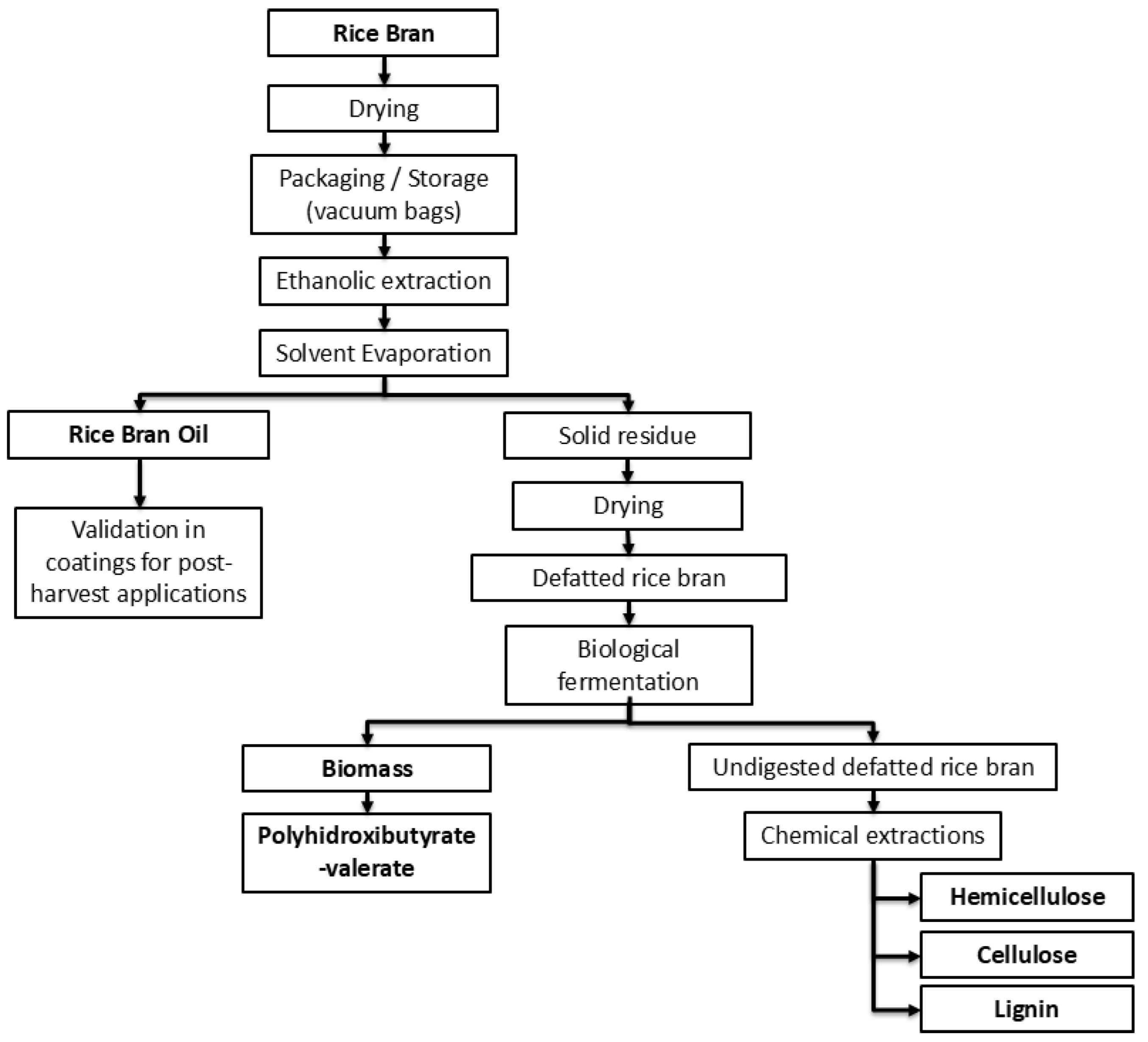
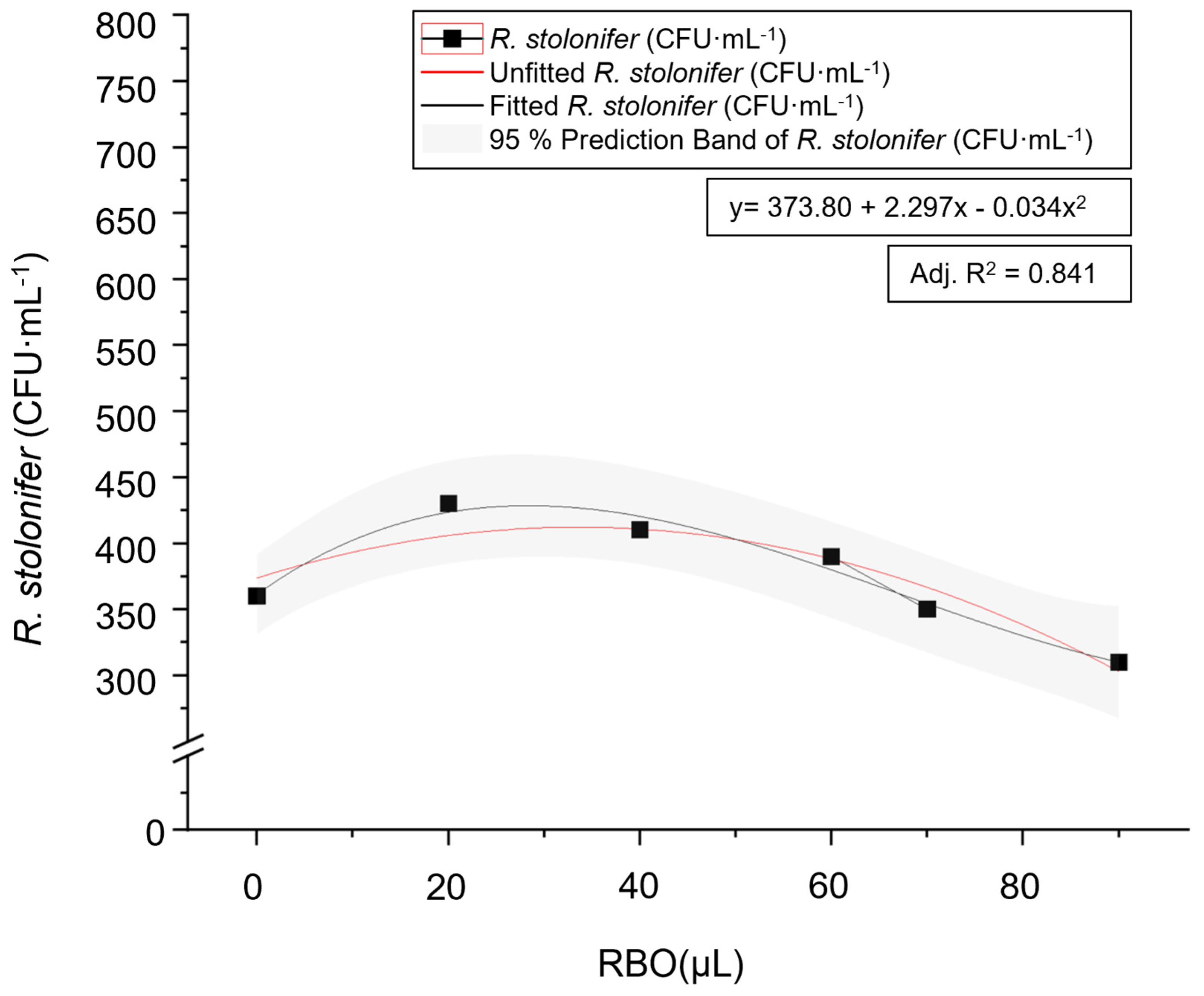
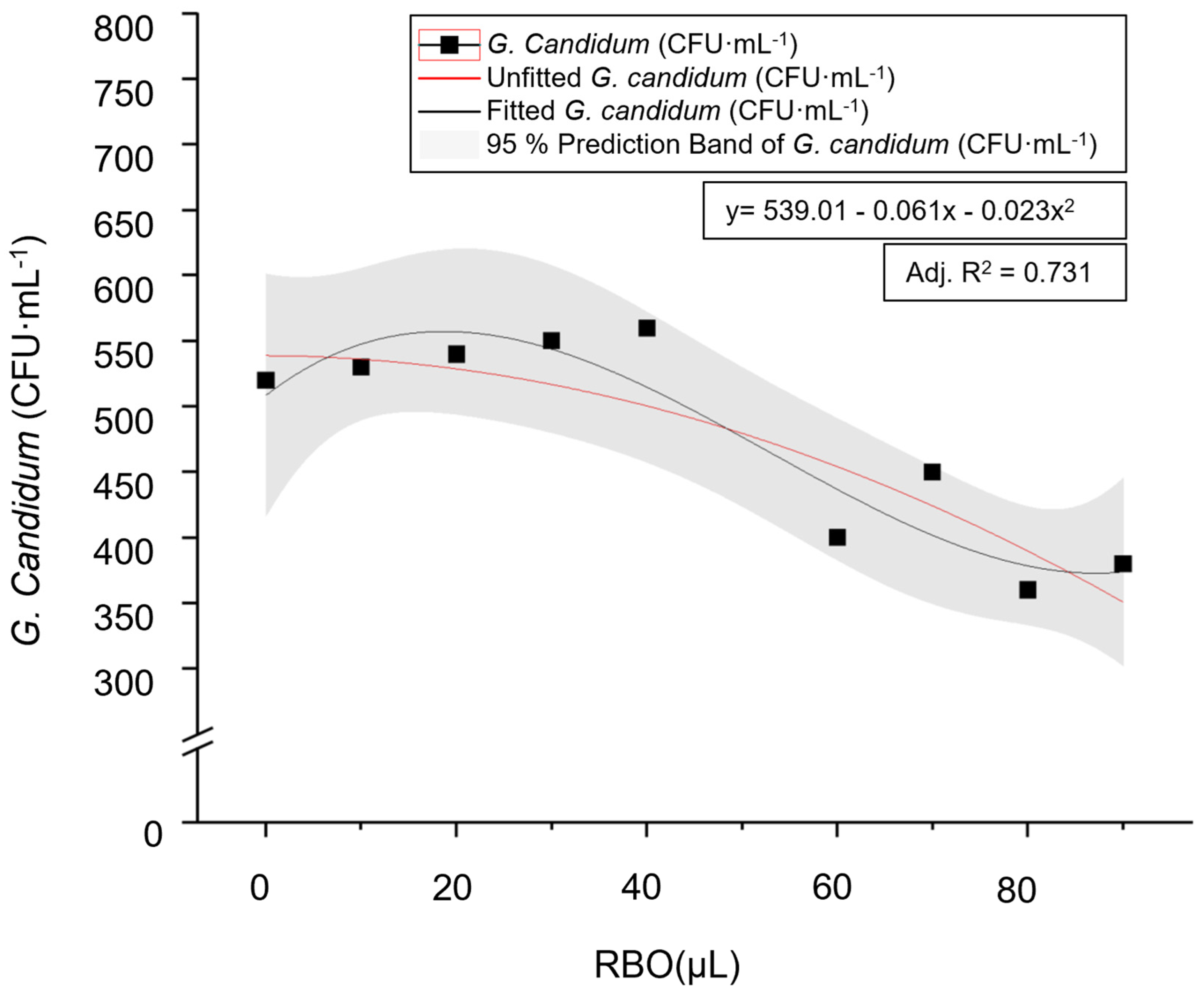
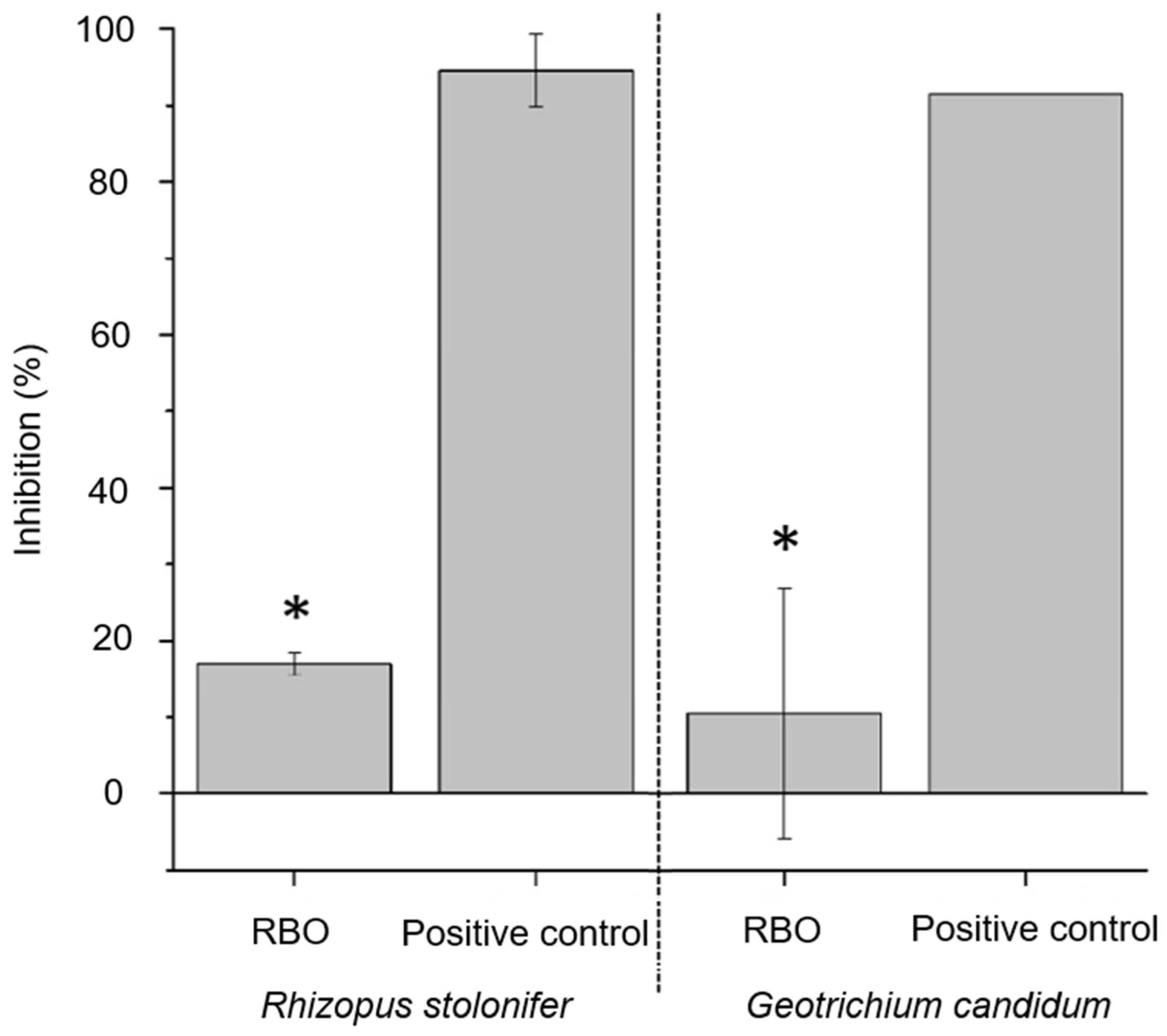
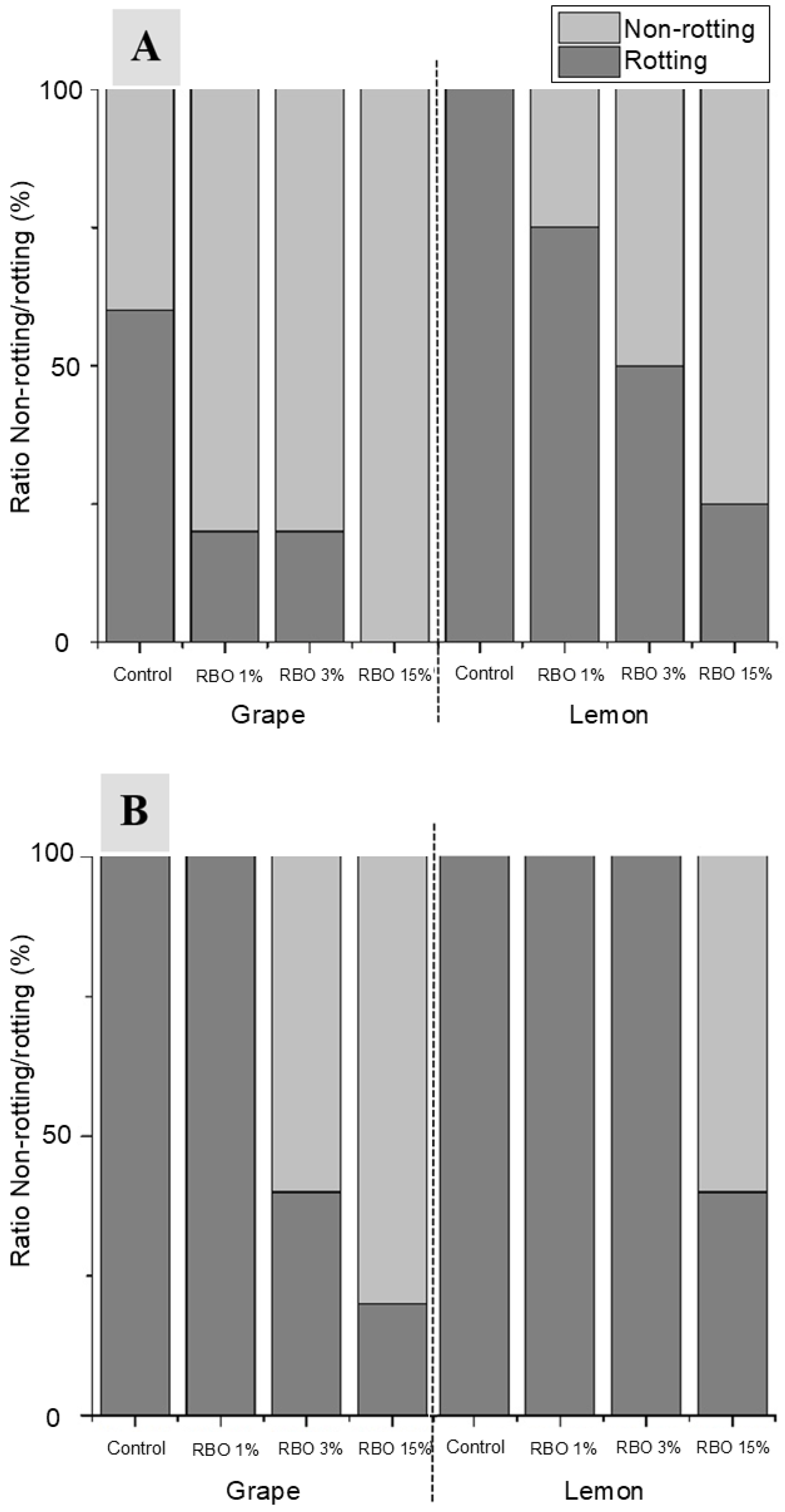
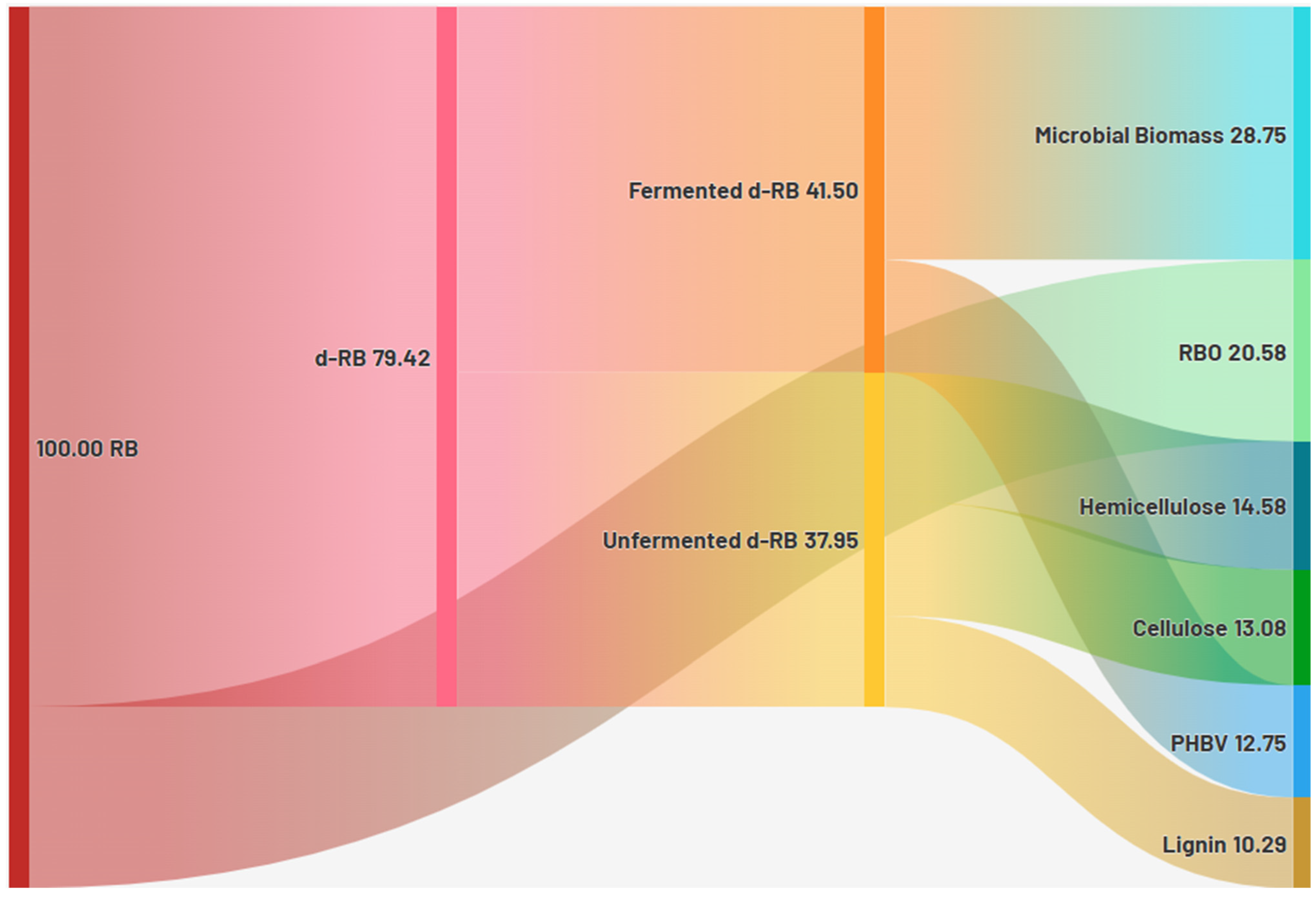
| Origin and Year of Harvest | Variety | Year of RBO Extraction | Extraction Process | Antioxidant Activity by ABTS Assay | SD | Research |
|---|---|---|---|---|---|---|
| Valencia (Spain), 2018 | Seria (Senia-Bahia) | 2018 | Ethanolic extraction | 1.47 (mg TEAC·g−1 DW of RB) | - | [9] |
| Valencia (Spain), 2018 | Seria (Senia-Bahia) | 2024 | Ethanolic extraction | 13.32 (mmol Trolox·mL−1 of RBO) | 0.84 | Our research |
| Chumphon (Thailand), 2014 | Dok-kham | 2014 | Ethanolic extraction | 34.94 (mg TEAC·g−1 DW of RB) | 1.26 | [32] |
| Phang-nga (Thailand), 2014 | Dok-kha | 8.36 (mg TEAC·g−1 DW of RB) | 1.04 | |||
| Satum (Thailand), 2014 | Khem-ngen | 7.23 (mg TEAC·g−1 DW of RB) | 0.27 | |||
| Chumphon (Thailand), 2014 | Nang-dam | 3.73 (mg TEAC·g−1 DW of RB) | 0.19 | |||
| China, 2019 | Oryza sativa L. Varieties: Nanjing, Wuyoudao, Yanfeng, Suijing, Longjing | 2021 | N’Hexane extraction assisted by ultrasonic | 1592.38–2106.47 (µmol TEAC·100 g−1 of RB) | NA | [33] |
Disclaimer/Publisher’s Note: The statements, opinions and data contained in all publications are solely those of the individual author(s) and contributor(s) and not of MDPI and/or the editor(s). MDPI and/or the editor(s) disclaim responsibility for any injury to people or property resulting from any ideas, methods, instructions or products referred to in the content. |
© 2025 by the authors. Licensee MDPI, Basel, Switzerland. This article is an open access article distributed under the terms and conditions of the Creative Commons Attribution (CC BY) license (https://creativecommons.org/licenses/by/4.0/).
Share and Cite
Navajas-Preciado, B.; Martillanes, S.; Galván, A.; Rocha-Pimienta, J.; Ramírez-Bernabé, M.R.; Delgado-Adámez, J. Rice Bran Biorefinery: A Zero-Waste Approach to Bioactive Oil and Biopolymer Production. Sustainability 2025, 17, 10219. https://doi.org/10.3390/su172210219
Navajas-Preciado B, Martillanes S, Galván A, Rocha-Pimienta J, Ramírez-Bernabé MR, Delgado-Adámez J. Rice Bran Biorefinery: A Zero-Waste Approach to Bioactive Oil and Biopolymer Production. Sustainability. 2025; 17(22):10219. https://doi.org/10.3390/su172210219
Chicago/Turabian StyleNavajas-Preciado, Bruno, Sara Martillanes, Almudena Galván, Javier Rocha-Pimienta, M. Rosario Ramírez-Bernabé, and Jonathan Delgado-Adámez. 2025. "Rice Bran Biorefinery: A Zero-Waste Approach to Bioactive Oil and Biopolymer Production" Sustainability 17, no. 22: 10219. https://doi.org/10.3390/su172210219
APA StyleNavajas-Preciado, B., Martillanes, S., Galván, A., Rocha-Pimienta, J., Ramírez-Bernabé, M. R., & Delgado-Adámez, J. (2025). Rice Bran Biorefinery: A Zero-Waste Approach to Bioactive Oil and Biopolymer Production. Sustainability, 17(22), 10219. https://doi.org/10.3390/su172210219







